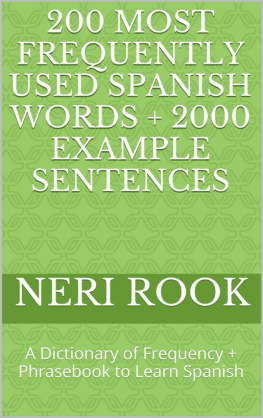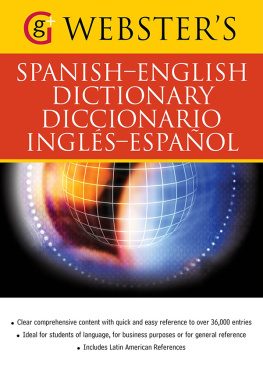 p.i A Frequency Dictionary of Spanish A Frequency Dictionary of Spanish has been fully revised and updated, including over 500 new entries, making it an invaluable resource for students of Spanish. Based in part on a new web-based corpus containing more than 2 billion words collected from 21 Spanish-speaking countries, the second edition of A Frequency Dictionary of Spanish provides the most expansive and up-to-date guidelines on Spanish vocabulary. Each entry is accompanied by an illustrative example and full English translation. The Dictionary provides a rich resource for language teaching and curriculum design, while a separate CD version provides the full text in a tab-delimited format ideally suited for use by corpus and computational linguists. With entries arranged both by frequency and alphabetically, A Frequency Dictionary of Spanish enables students of all levels to get the most out of their study of vocabulary in an engaging and efficient way. Mark Davies is Professor of Linguistics at Brigham Young University, USA.
p.i A Frequency Dictionary of Spanish A Frequency Dictionary of Spanish has been fully revised and updated, including over 500 new entries, making it an invaluable resource for students of Spanish. Based in part on a new web-based corpus containing more than 2 billion words collected from 21 Spanish-speaking countries, the second edition of A Frequency Dictionary of Spanish provides the most expansive and up-to-date guidelines on Spanish vocabulary. Each entry is accompanied by an illustrative example and full English translation. The Dictionary provides a rich resource for language teaching and curriculum design, while a separate CD version provides the full text in a tab-delimited format ideally suited for use by corpus and computational linguists. With entries arranged both by frequency and alphabetically, A Frequency Dictionary of Spanish enables students of all levels to get the most out of their study of vocabulary in an engaging and efficient way. Mark Davies is Professor of Linguistics at Brigham Young University, USA.
Kathy Hayward Davies is Adjunct Professor of Spanish at Brigham Young University, USA. p.ii Routledge Frequency Dictionaries General Editors Paul Rayson, Lancaster University, UK Mark Davies, Brigham Young University, USA Editorial Board Michael Barlow, University of Auckland, New Zealand Sylviane Granger, Universit catholique de Louvain, Belgium Barbara Lewandowska-Tomaszczyk, University of Lodz, Poland Josef Schmied, Chemnitz University of Technology, Germany Andrew Wilson, Lancaster University, UK Hongying Tao, University of California at Los Angeles, USA Chris Tribble, Kings College London, UK Scott Crossley, Georgia State University, USA Other books in the series A Frequency Dictionary of Arabic A Frequency Dictionary of Contemporary American English A Frequency Dictionary of Czech A Frequency Dictionary of Dutch A Frequency Dictionary of French A Frequency Dictionary of German A Frequency Dictionary of Japanese A Frequency Dictionary of Korean A Frequency Dictionary of Mandarin Chinese A Frequency Dictionary of Persian A Frequency Dictionary of Portuguese A Frequency Dictionary of Russian A Frequency Dictionary of Spanish (second edition) A Frequency Dictionary of Turkish For more titles, please see www.routledge.com/Routledge-Frequency-Dictionaries/book-series/RFD p.iii A Frequency Dictionary of Spanish Core Vocabulary for Learners Second Edition Mark Davies and Kathy Hayward Davies  p.iv Second edition published 2018
p.iv Second edition published 2018
by Routledge
2 Park Square, Milton Park, Abingdon, Oxon, OX14 4RN and by Routledge
711 Third Avenue, New York, NY 10017 Routledge is an imprint of the Taylor & Francis Group, an informa business 2018 Mark Davies and Kathy Hayward Davies The right of Mark Davies and Kathy Hayward Davies to be identified as authors of this work has been asserted by them in accordance with sections 77 and 78 of the Copyright, Designs and Patents Act 1988. All rights reserved. No part of this book may be reprinted or reproduced or utilised in any form or by any electronic, mechanical, or other means, now known or hereafter invented, including photocopying and recording, or in any information storage or retrieval system, without permission in writing from the publishers. Trademark notice : Product or corporate names may be trademarks or registered trademarks, and are used only for identification and explanation without intent to infringe. First edition published by Routledge 2006 British Library Cataloguing-in-Publication Data
A catalogue record for this book is available from the British Library Library of Congress Cataloging-in-Publication Data
A catalog record for this title has been requested ISBN: 978-1-138-68652-6 (hbk)
ISBN: 978-1-138-68654-0 (pbk)
ISBN: 978-1-138-68656-4 (CD)
ISBN: 978-1-315-54263-8 (ebk) Typeset in Trade Gothic LT Std
by Swales & Willis Ltd, Exeter, Devon, UK p.vi p.vii Frequency information has a central role to play in learning a language.
Nation (1990) showed that the 4,0005,000 most frequent words account for up to 95% of a written text and the 1,000 most frequent words account for 85% of speech. Although Nations results were only for English, they do provide clear evidence that, when employing frequency as a general guide for vocabulary learning, it is possible to acquire a lexicon which will serve a learner well most of the time. There are two caveats to bear in mind here. First, counting words is not as straightforward as it might seem. Gardner (2007) highlights the problems that multiple word meanings, the presence of multiword items, and grouping words into families or lemmas, have on counting and analysing words. Second, frequency data contained in frequency dictionaries should never act as the only information source to guide a learner.
Frequency information is nonetheless a very good starting point, and one which may produce rapid benefits. It therefore seems rational to prioritize learning the words that you are likely to hear and read most often. That is the philosophy behind this series of dictionaries. Lists of words and their frequencies have long been available for teachers and learners of language. For example, Thorndike (1921, 1932) and Thorndike and Lorge (1944) produced word-frequency books with counts of word occurrences in texts used in the education of American children. Michael Wests General Service List of English Words (1953) was primarily aimed at foreign learners of English.
More recently, with the aid of efficient computer software and very large bodies of language data (called corpora), researchers have been able to provide more sophisticated frequency counts from both written text and transcribed speech. One important feature of the resulting frequencies presented in this series is that they are derived from recently collected language data. The earlier lists for English included samples from, for example, Austens Pride and Prejudice and Defoes Robinson Crusoe , thus they could no longer represent present-day language in any sense. Frequency data derived from a large representative corpus of a language brings students closer to language as it is used in real life as opposed to textbook language (which often distorts the frequencies of features in a language, see Ljung, 1990). The information in these dictionaries is presented in a number of formats to allow users to access the data in different ways. So, for example, if you would prefer not to simply drill down through the word frequency list, but would rather focus on verbs for example, the part-of-speech index will allow you to focus on just the most frequent verbs.
Given that verbs typically account for 20% of all words in a language, this may be a good strategy. Also, a focus on function words may be equally rewarding 60% of speech in English is composed of a mere 50 function words. The series also provides information of use to the language teacher. The idea that frequency information may have a role to play in syllabus design is not new (see, for example, Sinclair and Renouf, 1988). However, to date it has been difficult for those teaching languages other than English to use frequency information in syllabus design because of a lack of data. Frequency information should not be studied to the exclusion of other contextual and situational knowledge about language use and we may even doubt the validity of frequency information derived from large corpora.
It is interesting to note that Alderson (2007) found that corpus frequencies may not match a native speakers intuition about estimates of word frequency and that a set of estimates of word frequencies collected from language experts varied widely. Thus corpus-derived frequencies are still the best current estimate of a words importance that a learner will come across. Around the time of the construction of the first machine-readable corpora, Halliday (1971: 344) stated that a rough indication of frequencies is often just what is needed. Our aim in this series is to provide as accurate as possible estimates of word frequencies. p.viii Paul Rayson and Mark Davies Lancaster and Provo, 2008 References Alderson, J. (2008). (2008).
Next page










 p.i A Frequency Dictionary of Spanish A Frequency Dictionary of Spanish has been fully revised and updated, including over 500 new entries, making it an invaluable resource for students of Spanish. Based in part on a new web-based corpus containing more than 2 billion words collected from 21 Spanish-speaking countries, the second edition of A Frequency Dictionary of Spanish provides the most expansive and up-to-date guidelines on Spanish vocabulary. Each entry is accompanied by an illustrative example and full English translation. The Dictionary provides a rich resource for language teaching and curriculum design, while a separate CD version provides the full text in a tab-delimited format ideally suited for use by corpus and computational linguists. With entries arranged both by frequency and alphabetically, A Frequency Dictionary of Spanish enables students of all levels to get the most out of their study of vocabulary in an engaging and efficient way. Mark Davies is Professor of Linguistics at Brigham Young University, USA.
p.i A Frequency Dictionary of Spanish A Frequency Dictionary of Spanish has been fully revised and updated, including over 500 new entries, making it an invaluable resource for students of Spanish. Based in part on a new web-based corpus containing more than 2 billion words collected from 21 Spanish-speaking countries, the second edition of A Frequency Dictionary of Spanish provides the most expansive and up-to-date guidelines on Spanish vocabulary. Each entry is accompanied by an illustrative example and full English translation. The Dictionary provides a rich resource for language teaching and curriculum design, while a separate CD version provides the full text in a tab-delimited format ideally suited for use by corpus and computational linguists. With entries arranged both by frequency and alphabetically, A Frequency Dictionary of Spanish enables students of all levels to get the most out of their study of vocabulary in an engaging and efficient way. Mark Davies is Professor of Linguistics at Brigham Young University, USA. p.iv Second edition published 2018
p.iv Second edition published 2018